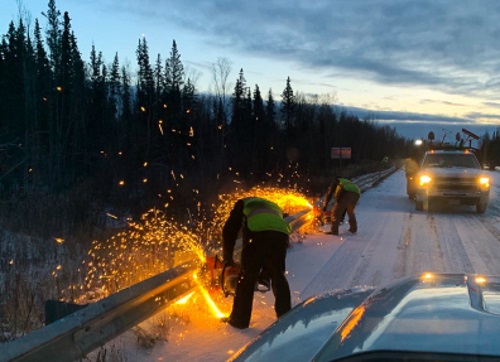Flexible yet stable long-term funding for infrastructure investment must exist in tandem with the ability to explain how such projects ultimately benefit their communities.
[In above photo clockwise from top left corner: Shawn Wilson; Eileen Velez-Vega, Victoria Sheehan; Tim Gatz]
Those were two of the key issues outlined by a panel discussion held May 11 during the American Association of State Highway and Transportation Officials 2021 virtual spring meeting.

“I think in many cases the citizens we serve take transportation systems we handle for granted — only after a national disaster do they recognize what those systems provide,” explained Victoria Sheehan, commission of the New Hampshire Department of Transportation and AASHTO’s 2020-2021 president.
“Where we fall short is discussing the outcome we achieve from projects,” she said. “If we can do more to talk about how ‘transformational’ large and small projects can be for our communities, I think that would resonate more with the public and with Congress. We also must demonstrate that we as state departments of transportation are efficient with the dollars we are given. That allows us to better detail the ‘why’ of what we do and what happens as a result of the [infrastructure] investments we make.”

Shawn Wilson, Ph. D. – secretary of the Louisiana Department of Transportation and Development and AASHTO’s 2020-2021 vice president – described that part of a state DOT executive’s job as “storytelling.”
“The job of storytelling is a very important part of the job we do in this space,” he stressed. “Everyday citizens and public officials don’t fully understand what it takes to get from point A to point B. And we don’t necessarily celebrate when we have a ‘win’ in transportation; that what we achieved is difficult even when we make it look easy.”

To achieve those “wins” on a steady long-term basis requires a stable yet flexible source of long-term funding, emphasized Tim Gatz, executive director of the Oklahoma Department of Transportation.
“There is no instant gratification in highway infrastructure investment, for example; it takes a long time and requires consistent long-term funding,” he said. “That is why we advocate for the formula funding system – it is really important to our ability to deliver projects now and in the future.”
Eileen Velez-Vega, secretary of Puerto Rico’s Department of Transportation and Public Works, noted that while her agency’s funding stream differs from that of other state DOTs because “we are a U.S. territory and not a state,” the need for “recurring and consistent funding” is a priority.

“We rely on federal funds to manage our transportation system,” she said. “We are responsible for 95 percent of the roads in Puerto Rico, so road maintenance a critical issue for us. That is where we have a lot of challenges as we do not have a recurring funding source every year for road maintenance. We need to get funds from local governments for maintenance. That’s why we need a recurring budget, so we do not have issues.”
Polly Trottenberg, deputy secretary of the U.S. Department of Transportation, agreed with the panel participants that a “steady and predictable stream of funding is very important, as is engendering performance out of those federal dollars.”

At the federal level, she explained that the country is “at a real transformational moment in transportation” and that it is “heartening to see both sides of the aisle move closer together especially on shared policies to create a transportation system to serve all our different states and communities.”
Yet the funding challenge remains – especially when the discussion centers on formula funding versus discretionary grant awards.
“It is no secret that the central tension in the federal transportation program – between not just grants versus formula funding and federal versus state, but states versus localities,” she said. “But discretionary grant programs are not going to replace formula funding – [grants] will remain a smaller part of what we do. But they do produce some interesting projects that sometimes can be overlooked by formula funding programs.”
New Hampshire Governor Chris Sununu (R) during a separate welcome message encapsulated the funding issue from the state perspective by noting that state oversight of infrastructure investment is “the key to everything” and not just about transportation.

“It’s about understanding that Washington D.C. doesn’t always have the best solution for Nebraska, New York, or my state of New Hampshire,” he said.
“You guys [state DOTs] are the ones who know what we need for our roads, bridges, and other infrastructure,” the governor noted.
“A lot of large cities need infrastructure investment, yes, but don’t forget about the rural communities – the ones that rely on local bus system to get to the doctor’s office or grocery store,” he explained. “Getting from point A to point B can be such a challenge in these times – and that’s why states need the flexibility to make the right funding investments for their communities.”



